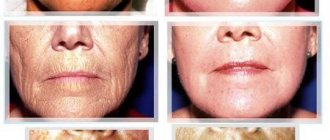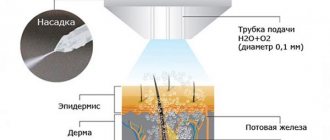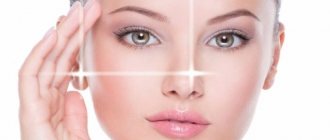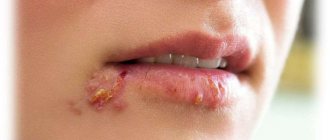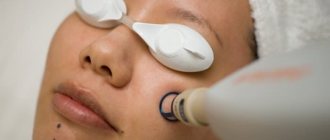Benefits of the procedure
Superficial cleansing of the skin with preparations containing mandelic acid does not affect the deeper layers, making it easily tolerated by cells. The procedure has advantages:
Versatility. The procedure is suitable for any age and people with different skin types. For this reason, it is most often recommended by cosmetologists.- The mildness of the action of the main component does not in any way affect the effectiveness.
- Typically, such sessions are recommended to be carried out outside the summer season. An exception is made for almond peeling. This cleansing can be done in any season. The main condition is the absence of tanning on the skin during the procedure.
- It is allowed to be carried out from 18 years of age. It is safe as it does not leave scars or acne.
- It is very convenient, as it allows you not to change your usual lifestyle. Does not have a long recovery process.
The mandelic acid used is also called phenoxyglycolic acid. It is obtained from natural almonds. The molecules have an increased size relative to particles of other acids. Due to this characteristic, they are not able to penetrate into the deeper layers of the skin. This makes the procedure completely safe.
The active substance has the following effects:
- Is an antioxidant. Binds and blocks free radicals that are harmful to youthful skin, and also removes heavy metal ions from cells.
- Has anti-inflammatory and antiseptic effects. Prevents the development of infections, destroys unwanted particles and stops inflammatory processes.
- Easily destroys solid protein without damaging cells.
- It has a stimulating effect on cellular renewal and the production of collagen and elastin.
- It gives good results in the fight against comedones and sebaceous plugs.
- Improves oxygen exchange in the epidermis, normalizes metabolism and increases the skin's resistance to external influences.
- Improves complexion by whitening age spots and freckles.
Why do you need peeling?
While the body is growing, all metabolic processes in it proceed quickly. During this period, the skin, if it is not affected by acne, looks fresh and smooth. She seems to glow from within with vitality. But as soon as growth ends, withering begins. The metabolism slows down, and the top layer of skin has time to become very keratinized before the body rejects it.
Gradually, the layer of dead cells becomes more powerful, and even natural skin renewal does not allow living cells to appear on the surface. The face loses its youthful freshness.
In addition, over time, collagen production in the skin decreases, and it loses elasticity, wrinkles and begins to sag.
But under the layer of dull, dead cells, life is still in full swing for the time being, and if you somehow remove this dead mass, the skin will look much younger. The peeling procedure is based precisely on this - using various methods, the entire mass of “old” cells is removed, and the living ones end up all at once on the surface, like many years ago.
In addition, the removal procedure, no matter how mild it is, always causes significant trauma, and in order to heal it, protective reactions are launched in the body - massive collagen synthesis begins, and the skin becomes younger before our eyes.
Modern peelings are carried out using different methods:
- mechanical - using brushes and various abrasives;
- chemical - using acid or enzymes;
- laser.
Technology and frequency
For lasting visible results, cosmetologists recommend 4 to 10 sessions with an interval of 7 or 10 days. The course is repeated after a year, and for preventive purposes peeling is allowed once every 2 months.
Cleansing using the substance is best done in a salon. The process begins with preparation:
- For a week or 2, it is recommended to use a cream containing 15% mandelic acid. It should be applied before bed. This will prepare the skin for the main procedure, reducing surprises for the skin. To enhance the effect, add the use of a cleansing gel containing fruit acids. It is used several times a week after sleep.
- If the client did not have the opportunity to prepare the skin, the cosmetologist will suggest shortening the exposure time for the first session.
- The specialist must conduct an allergy test on a sensitive area of the body.
- The face is cleansed with special milk. Remains of cosmetics, dirt, and sebaceous secretions are removed.
- The next step is to apply a tonic lotion containing 10% phenoxyglycolic acid.
- Pre-peeling is carried out. It consists of primary treatment with a weak solution of lactic, glycolic and mandelic acids. This is necessary to ensure deeper penetration of the active drug.
- The skin is not cleansed after treatment and the next step is to apply the main peeling composition. The cosmetologist treats the skin with phenoxyglycolic acid, the concentration of which ranges from 30 to 60%. In different cases, a specialist may add citric, lactic acid or alcohol additives for a drying effect. The duration of exposure varies individually, but does not exceed 25 minutes.
- At the end of the main stage, the peeling composition is neutralized with a special agent and washed off with water.
- The last step is to apply a soothing mask based on chamomile, calendula or aloe. After twenty minutes, it is washed off and the skin is treated with moisturizer.
Carrying out the procedure yourself at home is acceptable, but is not recommended by specialists. Preparing the skin in this case has the same recommendations, but choosing the right % of acid without a cosmetologist is difficult. To avoid violations in technology and dangerous consequences in the form of burns, alternative home recipes are recommended that will effectively replace almond peeling. Reviews from cosmetologists contain various recommendations.
I do not recommend that my clients use mandelic acid themselves, since even it can cause trouble if used incorrectly. I recommend one of three recipes:
- Mix chopped almonds and oatmeal in equal quantities. Add half of the milk powder and dilute with water until creamy. Apply the mask to clean skin, leaving for 20 minutes. Then rinse with water.
- Add honey and olive (grape seed) oil to the chopped nuts. Add 3 drops of 5% apple cider vinegar. The mixture should be applied to the skin like a scrub, with light rubbing. Leave on for 5 minutes and rinse off.
- This recipe uses equal parts ground almonds and oat flour. Add the same amount of aloe juice and warm water. Then add half the almond oil and a few drops of lavender ether. First, mix the dry ingredients in water, and then add the oils and juice. Hold for 10 minutes. If you have dry skin, do not use this mask more often than once every 10 days.
Natalya Vladimirovna, cosmetologist
How often should you exfoliate your face?
Self-care is a complex and step-by-step process.
From her youth, every well-groomed girl knows that the skin needs to be moisturized and nourished, but first it needs to be cleansed in order to prepare for these procedures. Daily washing, removing makeup and other superficial manipulations are necessary, but you can’t do without deeper cleansing. More precisely, you can do it, but without exfoliation, the skin will not be as smooth and radiant as you would like. So peeling is also a mandatory and regular skin care procedure. But how often should you exfoliate your face so that it brings benefits and not harm? After all, the deeper the impact, the higher the risk of harming the skin. We will tell you how often you can and should do facial peeling, as well as how to do facial peeling that suits your skin type, its condition and your goal. What is peeling?
Types and methods of facial peeling In the general understanding, peeling is the same as exfoliation, that is, removing “excess” skin. The excess is the upper, keratinized and non-living layer of the epithelium. It is formed as a result of the natural functioning of the skin. In its deeper layers, new cells are formed, and the old ones gradually die off and form a kind of protective barrier. In a certain amount, these cells are necessary for the safety and health of facial skin. But their excess makes it rough and dull. To ensure your skin radiates a healthy glow, you need to exfoliate your face and body. But if the skin on the body is quite dense, then the face requires more careful treatment. Therefore, you can’t do facial peeling often. But too rarely is useless. The frequency of facial peeling depends on many factors. This includes your natural skin type, health status, and time of year (climate). But it is even more important to choose the right type of peeling, that is, the products that will be used to exfoliate the skin. Depending on the composition of these products and their cosmetic effects, the following types of facial peeling are distinguished:
- Mechanical peeling
involves a physical and very light effect on the skin. Exfoliation using a scrub and or other abrasive materials is mechanical peeling. Mechanical peeling is very common and is most often done at home. - Dermabrasion
is the grinding of the skin and renewal of its top layer mechanically, but not manually, but with the help of a special apparatus. Such peeling is done only in a salon, where a cosmetologist operates the device and selects suitable grinding attachments. - Laser peeling
- This is also a hardware procedure, which consists of polishing the skin with a laser beam. It penetrates the epidermis and “evaporates” obsolete cells. Laser peeling is used to remove scars, acne marks and redness. This type of peeling visibly rejuvenates the skin.ultrasonic peeling
- Ultrasonic peeling
is based on the action of ultrasound, which gently exfoliates and polishes the skin. Ultrasonic peeling opens pores, cleanses the skin of the face and body without damaging it. - Chemical peeling
occurs due to the action of drugs on the skin that literally dissolve it. As a rule, these are acids and their derivatives that soften keratinized particles of the epidermis, which are then easy to remove.
All types of peeling, or exfoliation, remove dead cells and reveal the surface of new skin, and at the same time stimulate its regeneration. But the skin on different parts of the body and face differs in density and sensitivity. And the frequency of peeling is determined not only by its type, but also by the depth of impact (superficial, medium, deep). The deeper the impact, the less often such peeling can be done. How often should I do a chemical facial peel?
It is chemical peeling that requires the most careful analysis and choice, so first let’s find out how often you can peel your face with acids. The group of chemical exfoliant solvents includes a wide variety of acids of natural and laboratory origin:
- Fruit acids: glycolic, lactic, malic, tartaric, citric, etc.
- Antiseptic acids: salicylic, benzoic, trichloroacetic, etc.
- Synthetic acids: kojic, phytic, azelaic, retinoic, etc.
- Plant enzymes that destroy the peptide bond between amino acids in the proteins that make up skin cells.
In other words, the chemical peel procedure results in a chemical burn to the skin. Since this burn is not the result of an accident, but a controlled impact, its depth and duration are predetermined and strictly controlled during the process. However, even the slightest burn is an injury, and even its beneficial (stimulating renewal) effect should be minimal. Chemical peeling inevitably affects not only dead cells, but also living cells in the deeper layers of the epidermis, where acids penetrate. Under the influence of acid, the protein of living cells denatures (its structure is destroyed), which externally looks like intense redness of the skin. In medical terms, such redness, bordering on inflammation, is called erythema. Erythema is observed for quite a long time after peeling. Depending on its depth and composition, from 7-10 to 14-20 days. Accordingly, repeated peeling procedures are not carried out more often than this interval.
chemical peeling of the face The deepest variants of chemical peeling cause not only redness, but also actual hemorrhages in all layers of the skin. The epidermis bleeds as a result of such damage, and a scab forms in place of the pinpoint wounds. The scab lasts on average about two weeks, and the erythema that replaces it does not go away for months (from 2 to 4). Doing deep peeling is often prohibited, and simply impossible. As for specific dates, they can only be prescribed by the cosmetologist performing the procedure after a thorough examination before and after peeling. We can only say that for optimal results (fighting wrinkles, reducing pigmentation, etc.), the lightest superficial peels are usually carried out in courses of 4-6 procedures, each of which is carried out no more than once every two weeks. Medium and deep chemical peeling should be done once a year, maximum – once every six months. And at the same time choose the right time: early spring or late autumn, when solar activity is minimal. In addition, dark skin tone and enlarged pores make the procedure more difficult and reduce its effectiveness. Therefore, those with fair and thin skin can have their faces peeled more often than those with dark and tanned skin. How often should I exfoliate my face in a salon?
While chemical peeling can be done both in the salon and at home (in these cases different compositions and concentrations of acids are used), neither laser nor ultrasonic peeling can be done at home.
If you have chosen one of these procedures for yourself, then in any case you will find yourself at an appointment with a cosmetologist, who, after an examination, will select a suitable course, that is, the number and intensity of sessions. Without knowing the characteristics of the skin, we can only say that salon peeling is done a couple of times a week. Depending on the condition of the skin, from two to eight treatments may be required. Accordingly, you will visit a cosmetologist’s office every 3-4 days for a maximum of one month. This will be followed by a break necessary for complete restoration and rest of the skin. And then, if you want, the hardware peeling can be repeated. But that will happen no earlier than in six months. But if you do facial peeling with laser or ultrasound regularly, the skin will be renewed, but not damaged - in a word, ideal. How often should you exfoliate your face at home?
peeling at home Independent mechanical facial peeling, or scrubbing, can and should be done right from the age of 16-18. After 30 years, peeling becomes a mandatory procedure to maintain freshness and youth of the skin. Recipes for homemade scrubs and peelings are varied, and every family passes on its own folk recipes made from natural products from mother to daughter. But you can’t often peel even with the most natural ingredients. In general, the choice of peeling and the frequency of its use should depend not only on the fact that at one time it helped your mother and grandmother, but on the type and condition of your skin:
- For oily skin, peeling can be done 1-2 times a week. More often it’s not worth it, because this will provoke even more sebum production, and less often the effect of peeling will be invisible. Make a natural scrub for oily skin from coffee grounds, fine salt and sugar.
- For dry facial skin, peeling should be done less frequently: once every couple of weeks, or even less often (depending on the skin reaction). Dry skin needs a soft and non-traumatic scrub, which can be prepared from oatmeal, liquid honey, etc.
- Mixed skin types require careful exfoliation and scrub selection. You can, for example, peel the T-zone once a week to remove “blackheads” on the nose and chin, and do facial peeling as needed. For peeling mixed skin, use a natural scrub made from wheat bran, tea leaves, or buy a ready-made soft cream scrub.
- Normal facial skin tolerates home peeling best. Most quality cosmetic exfoliating products will work, but you can also buff with a mixture of sour cream or face cream with oatmeal, ground nuts and/or other natural abrasives. This peeling can be done every 3-4 days.
Even mild peeling traumatizes the skin to one degree or another. Do not overuse any type of peeling to prevent normal, healthy skin from becoming irritated, sensitive and/or dry. The optimal frequency of mechanical peeling can be considered weekly exfoliation in the warm season and peeling twice a week in autumn and winter. Well, salon cosmetic procedures are entirely under the responsibility of specialists who determine how often to perform facial peeling individually for each patient. Listen to the advice of your cosmetologist, do not be overconfident and exfoliate as often as your skin needs it. Beauty and health!
Indications for almond peeling procedure
Sessions are often conducted as preparation for more serious procedures. And also in the following cases:
- With a tendency to keratosis.
- For the purpose of removing pigment spots.
- At the first signs of photoaging.
- For unhealthy complexion.
- In case of impaired functions of the sebaceous glands.
- For correction of shallow scars and acne.
- To smooth out facial wrinkles and when skin texture is disturbed.
- In the treatment of rosacea.
Peeling and age
The question of peeling is very individual. Although the procedure is anti-aging, in some cases it can be performed even on 14-year-olds. It helps get rid of the consequences of severe acne, scars left after treatment for a staphylococcal infection or due to damage by demodex mites. After appropriate treatment, skin renewal through peeling helps restore appearance and give the face a healthy appearance.
Superficial peels refresh the skin and do not require a recovery period - the skin completely calms down after just a few hours. In fact, cosmetologists do not recommend carrying out this procedure unless absolutely necessary. But it can be simply impossible to dissuade fashionistas, so a frequency schedule has been developed, the violation of which can lead to serious problems. It looks like this:
- If the skin is normal, superficial peeling can be performed no more than 2 times a week.
- For dry skin – once every two weeks.
- For oily people – once every four days.
- For combination – 1-2 times a week.
If you peel more often, the skin will look fresh for a while, but then it will quickly become rough, begin to peel, become inflamed, pigmented areas will begin to form on it, and a vascular network will appear. In the most severe cases, extensive erysipelas develops, requiring long-term treatment.
Disadvantages of the technique and contraindications
Almond peeling has a number of disadvantages:
- at the purification stage, a drug with a strong specific odor is used;
- Sensitive skin may experience tingling and unpleasant pinching;
- high session price.
The disadvantages of the procedure also include a shorter effect compared to deep or medium. Before such serious sessions, at the preparatory stage, superficial types are used, including almond peeling.
Reviews from women about the use of drugs containing mandelic acid are varied, but most are positive. In some cases, there are complaints of pain during the session. Most often it is possible to achieve the desired result.
You should know when it is unacceptable to conduct sessions. Contraindications:
- Allergy to components of the composition.
- Wounds and other damage to the skin.
- Rashes of viral etiology and the presence of ulcers.
- Increased body temperature.
Contraindications
One of the most striking and obvious disadvantages of laser facial peeling is its numerous contraindications, which include:
- foci of inflammation (impetigo, sycosis, furunculosis), pustular rashes, very strong pigmentation, unhealed injuries (scratches, wounds, burns, abrasions);
- epilepsy, diabetes mellitus, tuberculosis;
- infectious diseases, exacerbation of herpes;
- elevated temperature;
- chronic diseases;
- pregnancy, lactation;
- presence of a pacemaker, serious disturbances in the functioning of the heart;
- oncology;
- tendency to form keloid and hypertrophic scars;
- exacerbation of skin diseases (psoriasis, eczema, atopic dermatitis);
- nevi, papillomas, molluscum contagiosum;
- face tattoos;
- problems with blood clotting;
- connective tissue pathologies (rheumatoid arthritis, scleroderma, lupus);
- the presence of subcutaneous fillers (fillers);
- intolerance to local anesthesia (lidocaine, novocaine);
- recent chemical peel (if less than 2 weeks);
- taking oral contraceptives and retinoids.
Moreover, if for other salon procedures there are absolute and relative contraindications, here they are all required.
On a note. If you decide to undergo laser peeling, be prepared to undergo a medical examination before the procedure to check for contraindications.
Skin care after sessions
Usually, a cosmetologist recommends a certain line of caring cosmetics and gives all recommendations regarding its proper use and skin care.
The general rules are as follows:
- In the first few days, when increased cell renewal occurs and the skin is very susceptible to any influences, you should use products with mild natural ingredients.
- Use sunscreen in open sun.
- In case of unusual manifestations, for example, malaise, herpetic rash, swelling and severe inflammation, immediately contact a specialist.
After this type of peeling, the following phenomena are possible:
- Hyperemia, or redness of the skin, may last for an hour.
- The burning sensation during the procedure quickly passes after its completion.
- With sensitive skin, peeling may persist for the first 2 or 3 days. These areas should not be torn off; they should be treated with a moisturizer.
- A rash that lasts 2 to 3 days is considered normal. In other cases, consultation with a specialist is required.
Cosmetology offers many ways to preserve beauty and youth. Chemical facial cleansing has gained many fans due to its effectiveness. Each session is thought out by a professional, which eliminates unwanted consequences. The specialist collects a detailed picture of the client’s condition and prescribes the required type of procedure, for example, almond peeling. Any type of treatment and rejuvenation has contraindications. It is necessary to take into account all the individual nuances of your body and tell your cosmetologist about them.
Rehabilitation period
Recovery may take varying amounts of time, depending on the type of procedure:
- for superficial dermabrasion - a week;
- after mid-grinding - 2 weeks;
- with deep - up to 3 weeks.
Proper care is aimed at rapid regeneration of the upper layer of the epidermis, which was removed during the procedure. To do this, a cosmetologist may recommend using products that protect against microbes, provide gas exchange, and stimulate cell migration and division. These include:
- hydrogels (polymers) for rapid wound healing;
- transparent antibacterial films protect against germs, allowing the skin to “breathe”;
- various therapeutic and cosmetic coatings based on collagen (for example, Integra artificial leather).
If facial care after laser peeling is complete, rehabilitation will be accelerated, and the risk of complications is significantly reduced. Some factors slow down tissue regeneration. They should be avoided at all costs.
- Do not expose your face to hypothermia and low temperatures.
- Make sure that the humidity in the room meets the standards.
- Avoid cold air.
- Use cosmetics with ultraviolet filters at any time of the year.
- Do not remove crusts formed after the procedure.
- Do not use decorative cosmetics.
- Don't sunbathe.
Helpful advice. When going to the salon, keep in mind that it is better not to go to work for 1 or even 2 weeks, since the skin with a crust formed on it will have a very unesthetic appearance. Take vacation or time off.
Facilities for carrying out
You can perform chemical facial peeling at home using:
- natural products that contain active ingredients that have a peeling effect;
- professional cosmetics used for peeling procedures in the salon;
- pharmaceutical preparations and preparations from the list of stores for soap making and homemade cosmetics, which contain active ingredients included in peeling preparations.
The main components that have an exfoliating effect on the skin:
- enzymes (aka enzymes);
- acids.
Video: About chemical peeling
Contraindications and advice from a cosmetologist
Peelings are indispensable in quality facial skin care. This is the minimum that should be carried out by every woman, and according to indications - by men.
Contraindications must be taken into account:
- skin diseases;
- autoimmune diseases;
- allergic and hypersensitive skin;
- Peeling should not be carried out if the body is weakened by bacteria or viruses.
Recommendations from cosmetologists for those who have undergone the procedure:
- It is prohibited, until complete recovery, to visit saunas, baths, and solariums. Sunbathing in spring and summer is strictly prohibited.
- Do not touch your face with your hands to avoid tissue infection. Use only medicinal and moisturizing sprays recommended by your cosmetologist.
- Do not use decorative cosmetics until tissue regeneration is complete.
- Be sure to use sun protection when going outside.
- Do not tear off the crusts on your face with your hands. The process must go through all stages of healing on its own. Otherwise, scars will form on the face.
- If there is the slightest suspicious change or suppuration on the face, immediately contact your cosmetologist.
Follow all the recommendations of a professional specialist, and the result of the procedure will please you for a long time.
Peeling frequency depending on the depth of exposure
Peels are distinguished by the degree of impact on the skin. Let's take a closer look at the nuances of each of them:
Surface
The easiest and most gentle type of this type of cleaning. The chemical does not penetrate deep into the skin and does not affect living cells. Most often, fruit or lactic acid is used. The solution has a small (up to 20%) concentration percentage, which explains the surface effect.
Mechanical superficial peeling is also possible, based on manual cleaning of the stratum corneum.
It can be performed once before a course of deeper effects to pre-clean the skin. If we talk about an independent procedure, it is recommended to take a course of 4–10 sessions.
The break between procedures is from 1 to 1.5 weeks. The duration of the course depends on the problem: getting rid of pigmentation, anti-aging effect or acne treatment.
Depending on your skin type and sensitivity, your face may turn red after the procedure, and after a couple of days it may peel. This is a natural phenomenon, you just need to use moisturizing creams more often and give up decorative cosmetics for a while.
Median
It affects the entire depth of the epidermis when a deeper effect on the problem is needed. These may be signs of photoaging, medium and deep wrinkles, as well as age spots and moles on the face. The procedure is performed for women over 25 years of age. The chemical medium peeling agent is trichloroacetic acid with a rate of 20-50%. Hardware peeling is possible.
After treatment, the skin receives a slight burn; recovery after each procedure lasts 2 weeks. The course, depending on the problem, ranges from 3 to 10 sessions.
Deep
The impact is carried out on the entire depth of the epidermis and half of the layers of the dermis. The deep type is used extremely rarely due to the aggressiveness of the impact and the very long recovery period. This type includes hardware, mechanical and chemical peels.
Of course, the client receives a powerful aesthetic rejuvenating effect, but the procedure itself is painful and requires patience and great care in the post-peeling period.
Cosmetologists recommend using deep treatments as a last resort (for example, to get rid of a scar). The frequency of repetition of the procedure is at least a year.
Note! The more aggressive the peeling, the longer the skin recovers after the procedure. But there is also a positive nuance - the rejuvenation effect occurs faster and lasts longer.
What is peeling
In order to undergo chemical peels safely and as effectively as possible, specialists have developed several techniques, each of which has its own characteristics. The composition for this procedure can be applied to the skin using gauze pads, brushes, sticks, and cotton pads. Peel exposure can be determined by several factors: swelling, erythema, burning, soreness and frost effect.
Unpleasant sensations appear depending on the acid, since due to exposure to the skin, it also has contact with the nerve endings that are located at its surface and provoke a burning sensation. Today, there are even new types of peelings, in which blockers are added, with the help of which pain is reduced and the inflammatory reaction is minimized.
You need to understand that any peeling is a procedure after which redness of the skin appears, as well as peeling. This redness can last from a third of an hour to a person and even four weeks. After superficial peeling has been carried out, the process of disappearance of reddened skin lasts no longer than two hours, but with superficial-medium peeling it takes two days. Even with medium peeling, redness lasts up to a week. The quality and nature of peeling also depends on the type of peeling chosen. This process should not last more than a week if medium and superficial peeling was used. Swelling is a normal reaction to mid-peelings, but when peeling with AHA acids it usually does not occur. Next we will look at how the peeling procedure itself occurs.
Cleansing
This cleansing is usually done with hyaluronic acid and milk, which are very suitable for the skin of the face, as well as for delicate areas around the eyes and eyelids. This cleansing is universal, since it does not irritate the skin, and its components are harmless even in the summer. After cleansing, the face is additionally wiped with tonic with hyaluronic acid. And only after this, cleansing cream (5%) is applied. It is with its help that the remaining sebum and fat are removed, the acidity is also leveled and it works to ensure an evenly distributed supply of acid into the skin. But you need to remember that this gel should never be used around the eyes! It is also strictly forbidden to cleanse the skin on the face with soap or other products. This leads to a change in the acidity level, and also greatly worsens the effect of the peeling procedure.
Application of acid
A gel is applied to the skin of the face using a brush, which follows a certain long-standing sequence: the forehead, then the nose and temples, then the side surface of the cheeks and chin, as well as the central-middle part of the face and the fixed part of the face. In the case of the eyes, their area must be outlined, retreating from the edge of the upper eyelid by a centimeter and from the lower by half a centimeter.
Neutralization
If you notice any of the signs that are written below, then you must urgently interrupt the peeling procedure. Mild erythema or very strong burning may occur. It is also necessary to say about the time of the procedure. For a regular peeling procedure, it takes about fifteen minutes, but for the skin of the eyelids it takes up to 2 minutes. Now we have reached neutralization, which ultimately causes a skin burn.
Timing
The cosmetologist needs to note the time of how long the peeling exposure lasts. Adaptation of the skin to acid occurs by gradually increasing the procedure time.
Removing residues
The further instructions are very simple; the remaining acid and neutralizer must be washed off with a large amount of water.
Frequency of chemical peels
Many women prefer chemical exfoliation due to the variety of its types, purpose and speed of solving aesthetic problems. Acid and enzyme compositions of the required concentration allow you to exfoliate the skin at a certain depth, thereby correcting not only minor defects in appearance (for example, facial folds or acne), but also reducing serious age-related changes, hyperpigmentation and rosacea. Let's find out how often to do chemical peeling of the face in the case of superficial, medium and deep techniques.
- Superficial peeling. Such acid or enzyme exfoliation “dissolves” only the top layer of the epidermis. Most often, surface manipulations are performed using fruit, glycolic and lactic acids, as well as enzymes and peptides. The purpose of superficial peelings is to combat mimic and first age-related skin changes and signs of photoaging.
A course of superficial peelings consists of 5-8 sessions, with a mandatory break between them of 10 to 14 days. The interval between courses is 4-6 months.
- Medium peeling. In addition to correcting minor imperfections in appearance, mid-face cleansing helps prolong youth, get rid of hyperpigmentation, bumpiness after acne, and inflammatory processes. For medium peels, more concentrated acid preparations are used, which are washed off with neutralizers. This type of exfoliation is dangerous to perform at home; it is better to trust a professional. As a result of medium peels, acid molecules can penetrate to the granular layer of the dermis, so chemical burns must be controlled. Frequent use of TCA peels, retinoic peels, azelaic, phytin, pyruvic and their analogues leads to complications.
It is necessary that the course of medium peels consist of no more than 3-4 sessions with a break of 2 weeks. Such exfoliation is carried out only once a year in autumn or winter.
- Deep peeling. This is a serious exfoliation that can only be performed in a beauty salon. The destruction of the entire layer of the epidermis and the initial layer of the dermis occurs with the help of toxic phenolic acid. Deep peeling is only suitable for mature skin or skin with scars and scars.
A course of deep phenol peeling consists of 1 procedure, which must be repeated no more than once a year and only in the autumn-winter season. Only 3 sessions of deep exfoliation are allowed in your entire life.
Only a professional cosmetologist can choose the correct frequency of peelings for a woman. After all, rare exfoliation will not bring results, and frequent exfoliation is dangerous with the risk of side effects.
Facial care includes the use of special cosmetics to cleanse and soften the skin. But this is not enough. To make your face look fresh and youthful, it needs to be cleansed of dead cells. They handle this well. But this procedure, if repeated frequently, can harm the skin. How often should I do it? We will talk about this in the article.
The importance of interval between peels
Exfoliation is one of those beauty procedures that helps a woman prolong her youth by correcting age-related defects in appearance, but at the same time it requires a clear cyclical implementation. Patiently maintaining certain intervals between peels is also important, as is choosing the right cleansing, following the procedure protocol and the stages of post-peel skin care.
The process of mechanical, hardware or chemical cleansing of the face involves the artificial destruction of the keratinized epidermal layer and stimulation of regeneration inherent to the skin. A physical or acidic agent, in contact with the middle or deep layers of the dermis, causes serious changes in cellular structures. In an effort to replenish the protective barrier damaged by peeling, the skin begins to intensively produce collagen and elastin fibers, cell division accelerates, the supply of micronutrients to them, and blood circulation is normalized. The dead epidermis is replaced by a young and tender one. Along with scales and crusts, peeling removes facial and age wrinkles, age spots, redness, enlarged pores are cleaned and narrowed, scars become invisible, and many dermatological diseases, such as rosacea and acne, disappear.
Provoked chemical or thermal burns and grinding with fine abrasives cause significant damage to the skin. For women, peeling is a rejuvenation and an effective way to get rid of aesthetic defects, but for the skin it is a colossal stress. Even if the facial cleansing course was performed at home and not in cosmetology, give your skin a rest. Many peelings require at least 3 months for the epidermis to fully recover after the procedures, so getting carried away with exfoliation is strictly prohibited.
The interval between peels is not a universal amount of time. The duration of the intervals depends on many factors. First of all, it depends on the type of exfoliation and the depth of exposure of the skin to acidic compounds and abrasive particles. The deeper the peeling, the longer the skin will heal.
How long you need to take a break between peels depends on:
the depth of penetration of chemical compounds, laser beams and other agents that disrupt the upper layer of the epidermis. Deep peelings require the longest rehabilitation after procedures, scrubbing at home – minimal; woman's age. Young skin does not require frequent care, unlike aging skin, which requires regular support; reasons for aesthetic defects. Anti-aging exfoliation needs to be repeated much more often than, for example, procedures to reduce acne or signs of photoaging; skin type. Dry facial skin requires careful treatment and rare exercise; oily or combination skin, on the contrary, needs constant normalization of the sebaceous glands.
Frequency of physical peelings
Physical facial peels are a broad concept. They combine mechanical and hardware methods of skin renewal, which are performed both in the salon and at home. During physical exfoliation, dead epidermis is polished using small abrasive elements, which include particles of natural scrubs (ground coffee beans and fruit seeds, sea salt), diamond dust or coral chips, water and oxygen molecules supplied to the skin under high pressure during gas-liquid peeling . Mechanical cleansing also includes exfoliating the skin with soft brushes and sponges, liquid nitrogen (cryotherapy), ultrasound and a laser beam (laser peeling or resurfacing).
For the most part, physical facial peeling in the salon and at home is a gentle superficial exfoliation, aimed more at correcting external defects and stimulating metabolism than at serious rejuvenation. In addition to laser exfoliation, which is an effective remedy against wrinkles and other age-related skin changes. Let's figure out how often to do facial peeling in the case of specific mechanical and hardware techniques.
- Brossage. This superficial exfoliation involves hardware exfoliation of the skin with soft massage brushes and elastic sponge attachments. Brossage carefully removes dead epidermis and stimulates blood flow to the deep layers of the dermis, improving their nutrition. As a light skin renewal or to prepare it for more serious peelings, brossage is recommended to be performed at any time of the year in a course of 8-10 procedures.
The break between procedures is 1-2 weeks (depending on the sensitivity of the skin), the interval between courses is at least 3 months.
- Scrubbing. Superficial cleansing of the skin with organic scrubs with natural particles can be done both in salons by professional hands and at home. Scrubbing compositions contain crushed coffee beans, fruit seeds, bodyaga, sugar, sea salt or coral dust. A course of mechanical peeling with scrubs consists of 6-8 procedures.
Those with oily and combination skin can take a short break between procedures – 7 days. Dry skin is more damaged, thins out faster and takes longer to recover; for it, the interval between scrubbing sessions is 2 weeks. The interval between peeling courses is the same for all skin types - 3 months.
- Ultrasonic peeling. Facial cleansing using high-frequency ultrasonic waves is one of the safest and most gentle superficial peeling techniques. The acoustic wave breaks down the old epithelial cells - as a result of the procedure, the complexion is evened out and the skin takes on a refreshed appearance. Ultrasonic exfoliation is rarely carried out as an independent course; it mainly serves as preparation for other types of peeling, for example, chemical peeling.
For oily, combination and aging skin, 4 to 8 ultrasound procedures are required once a week. For dry and sensitive – 1-2 manipulations per month. The break between courses is at least 3 months.
- Gas-liquid peeling. This physical exfoliation is performed only in a beauty salon using expensive equipment. Mechanical exfoliation of the stratum corneum of the epidermis is performed without direct contact with the skin using a cold water jet enriched with carbon dioxide and oxygen. Sometimes antiseptic drugs can be added to the peeling composition (for example, to treat acne or acne). A water jet at supersonic speed destroys the old epithelium and improves blood supply to the deep layers. As a result of the peeling course, skin unevenness, wrinkles and scars are smoothed out, pigment spots are lightened, and inflammation goes away.
The course of gas-liquid peeling includes from 4 to 6 sessions with a frequency of 1 week. The interval between courses is 3 months.
- Microcrystalline dermabrasion. This peeling is of the medium-deep type. During the hardware procedure, dead epidermis on the entire face or only problem areas is polished using special diamond-coated cosmetic attachments. Diamond brushes help reduce the network of wrinkles, improve complexion, remove pigmentation, scars and scars. Sometimes microdermabrasion is performed using application anesthesia, which means that the skin is seriously injured and requires a long time to heal.
A course of microcrystalline dermabrasion includes 4 to 6 peeling sessions. Manipulation can be performed no more than once every 10-14 days. The interval between courses is from 3 months to six months (depending on the type and reaction of the skin).
- Laser peeling or resurfacing. Another medium-deep peeling for facial skin, designed to solve anti-aging problems, eliminate the consequences of dermatological diseases or injuries. The laser beam produces a controlled thermal burn on the skin, thereby stimulating the production of “fibers of youth” - collagen and elastin. Laser peeling is one of the effective ways to rejuvenate aging skin and combat old scars or scars.
The number of procedures in a laser peeling course is from 6 to 8. The break between sessions is at least 1 week. The interval between courses is about 4 months.
The average for all physical peelings (salon and home) are two time parameters: the interval between mechanical cleansing procedures should be at least a week, and the break between courses should be at least 3 months.
